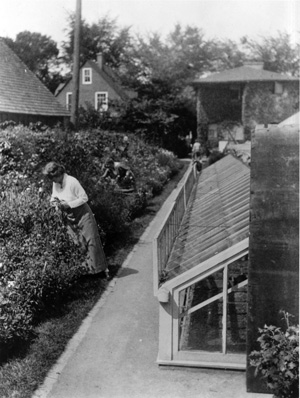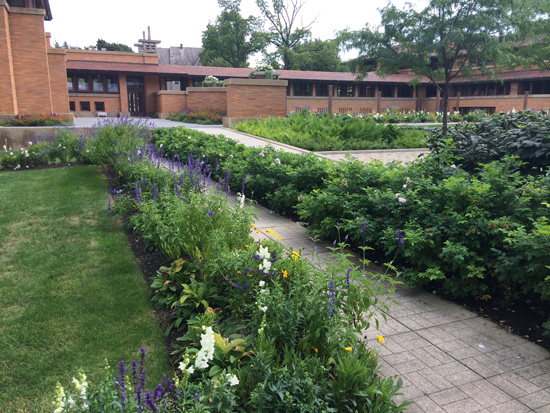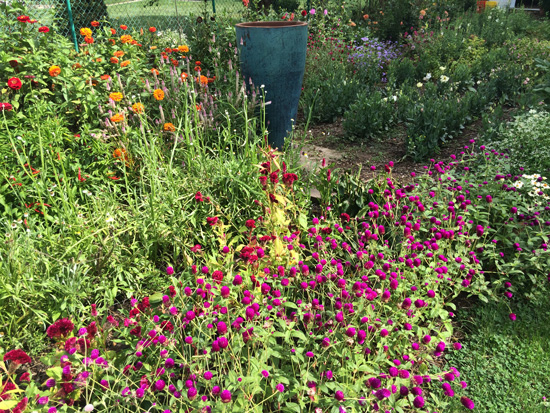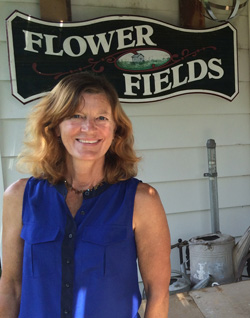
Horticulturist Nellie Gardner in the Darwin Martin House courtyard. Photo by David Clark
Nellie Gardner is trying to learn how to relax. This is not an easy thing for someone who spent her adolescence on a self-sufficient farm on resource-poor land in Cape Breton, Nova Scotia. Gardner’s free-spirited parents, former teachers who decided to exit the grid altogether, learned self-sufficiency as they went. Gardner and her siblings worked alongside their parents and didn’t go to high school, something that didn’t stop her from attending an Ivy League college.
“Since we were always scrambling for our next meal, we were always working, moving, and thinking about how we were going to feed ourselves,” she says. “It did affect my ability to relax as an adult. Even my non-work pursuits have to have a purpose … it’s bad,” she says, laughing.
On the bright side, growing up in this hardscrabble setting, Gardner learned many useful skills those of us raised in suburbs might envy. She’s used these skills to renovate six historic homes, run a cut flower business for 25 years, and earn the position of horticulturist for the Frank Lloyd Wright–designed Martin House Complex in Buffalo and for Graycliff, the Martins’ former summer home on Lake Erie, also designed by Wright. The Martin House, completed in 1905 and once home to Darwin and Isabelle Martin and their extended family, is Buffalo’s most popular tourist destination.

Panorama of the Martin House from the visitor center taken in 2009 after building restoration but before garden restoration. Free for use by Cygnusloop99 – Own work, CC BY-SA 3.0, https://commons. wikimedia.org

The front of Darwin Martin House in 1969. Courtesy University Archives, State University of New York at Buffalo

Isabelle Martin working in her cutting garden circa 1908. Courtesy University Archives, State University of New York at Buffalo
Gardner says, “This position at the Martin House and Graycliff pulls together so many of my interests and abilities—history and historic homes and landscapes, architecture, horticulture, education … I really feel called to be here to help tell the story of the Martins and their relationship with plants.” Gardner says that landscape architects regard the Martin House landscape as the most significant of Frank Lloyd Wright’s landscapes because of how highly developed it was, and will again be. “They also say that the landscape of the Martin House is at least 40% of the story of this place,” she says.
Gardner had been a volunteer for several years at the Martin House and was eventually recruited as horticulturist in 2011. For several years she commuted from her Spencerport farm—and the farmhouse she’d renovated—until last spring, when she sold the Spencerport property in order to move to Clarence Center so she’d be closer to work. The hardest part about leaving the Spencerport property was letting go of its beautiful sandy loam soil, a remnant of the ancient Lake Iroquois. “It was easy to grow flowers there,” she says. “I developed my own recipe for growing as well as for bouquet making.”
Her interest in soils and plants as a young person led her to study agriculture at Nova Scotia Agricultural College (NSAC) in the late 1970s and then agronomy at Cornell. Gardner won an international cattle-judging competition while at NSAC, and that, she says, helped her get into Cornell. After Cornell, she studied ecology in a master’s program at SUNY Brockport. (It’s a good thing Gardner was in no way discouraged when her advisor at NSAC told her to “do something more suitable for a woman, like be a secretary.”)
Gardner went on to develop pest scouting methods and disease forecasting systems for Cornell Cooperative Extension (CCE) while working in integrated pest management (IPM) at the Geneva Experiment Station, and she served as CCE Vegetable Specialist in Batavia. Eventually she struck out on her own as a professional agricultural consultant, where for seventeen years she helped large growers lower their input costs while reducing crop risk, improve their scouting methods, and computerize their crop and farm records to enable better decision making. Concurrently, she started Flower Fields, her cut flower enterprise, and completed one historic house renovation after another.
“The homes I rehabilitated sold immediately,” she says, “because I had restored the feeling of cohesiveness and comfort that comes from all of the house’s features being of the same era. I’d buy lighting, kitchen cabinets, flooring, and other features from ReHouse in Rochester that were era-appropriate and would restore the visual coherence of the home. That’s why I’m so drawn to Frank Lloyd Wright’s architecture, because it’s all about the subliminal effects of coherence that add up to making you feel good when you enter a space. It’s a masterful achievement of making the house and landscape a unified whole.”
Gardner brought this vision to her volunteering at the Richardson Olmsted Campus in Buffalo, where she developed and gave tours of the Olmsted-designed grounds of this former psychiatric treatment center. “Your surroundings can affect how you feel and not everybody understands that,” she says. “The people who ran the Richardson Campus knew that and they harnessed the healing powers of nature by involving the patients in the enjoyment and cultivation of the grounds. Olmsted, himself a farmer as well as a landscape architect, got it.”
• • •

The original courtyard gardens with peonies for cutting, circa 1905. Courtesy University Archives, State University of New York at Buffalo

The courtyard today as Nellie Gardner plants and maintains it. Photo by Michelle Sutton
Nellie Gardner’s first encounter with the Martin House complex was in the early 2000s, when she took a tour with her brother, also an appreciator of Frank Lloyd Wright. At the time the complex, first completed in 1907 but having suffered neglect mid-century, was newly under restoration via the Martin House Restoration Corporation (MHRC), founded in 1992. On Nellie’s first visit, an ugly 1960s-era apartment building loomed right in the middle of the complex, and the landscape no longer resembled Wright’s vision for it.
Gardner gravitated toward the institution because it held so much historic promise, it united so many of her interests, and there was so much work to be done. In 2006, she began volunteering in the gardens and researching them, especially original owner Isabelle Martin’s cut-flower gardens, some of which were under glass. Gardner spent many hours in the University of Buffalo archives, which also has a digital collection, learning about Frank Lloyd’s Wright intentions for the landscape, including his vision for harmony between the house and landscape.
When the MHRC recruited her to be its horticulturist, she continued the work of restoring the central gardens of the complex with the help of volunteers. Bayer Landscape Architects of Honeoye Falls have created plans for bringing back the most ambitious original feature of the grounds, a 95-foot-long floricycle, a semi-circular mixed planting of shrubs, perennials, bulbs, and annuals wherein a grouping repeats 12 times. Originally installed in 1905, the floricycle created an outdoor gathering place for family events like the wedding of Darwin and Isabelle’s daughter Dorothy in 1923. Some of the original floricycle shrub specimens, including snowberry, lilac, spirea, and mockorange are in waiting on other parts of the property. “At one time there were 18,000 plants in the floricycle,” Gardner says.
In her research, Gardner found that at its peak, there were over 300 different plant species on the grounds at large. She says, “There were English borders, picking borders, lots of sturdy old-fashioned perennials like phlox, anemones, peonies, irises, and even plume poppy. We’ll be editing that list—for instance, we may forego plants that are on the NYS Invasive Plant List—at least those that are a problem in our region. And whereas they planted wisteria right against the house, we will put it on trellises well away from the buildings, so it doesn’t degrade structures like it once did.”
The grounds were once dotted with American elms and surrounded by elm street trees. The only remaining tree original to the landscape is a European copper beech that Darwin Martin planted in 1905 in consultation with Wright. However, trees have been added over the decades and Gardner is studying to be a Certified Arborist so that she can better manage the tree collection. “I would have loved to have been here to experience the overarching canopy of the American elms,” she says. “You can tell from pictures that they made it feel very intimate within this setting and encouraged a relationship with nature. When you’re here at night and there’s no one around, you can feel what that must have feel like—that intimate communion with nature.”
Gardner also teaches classes for the community in the gorgeous main Martin House on topics like pruning, flower arranging, and wreath making. (Her signature for the latter is incorporating ornamental hot peppers that she grows herself; her wreaths will be featured later this year in a story in Country Gardens magazine.) Gardner also coordinates the garden volunteers and leads tours of the grounds. She is the only paid garden staff for the Martin House and Graycliff. She is a busy woman.
• • •

Gardner’s cutting garden in Clarence Center. Photo by Michelle Sutton

Gardner has operated Flower Fields in several different places over the course of 25 years. Photo by Michelle Sutton

Farmer is Gardner’s new family member and is also very much interested in historic restoration. Photo by Nellie Gardner
One of Gardner’s favorite things to do in her free time is to take multi-day bike or kayak trips along the Erie Canal. “I love studying the canal’s history and how our cities and state grew up around it,” she says. When she lived in Spencerport, she and a friend ran a tour boat on the Canal that made local forays. “Someday I’d like to get a tour boat and take people on the Canal all the way down to NYC,” she says. “I’d take them into towns along the way that have these historical treasures. For example, there’s the Peppermint Museum in Lyons, which at one time was the peppermint capital of the world. The museum is housed in the former packinghouse of the H.G. Hotchkiss Essential Oil Company and the lower level opens out onto the canal, where they would receive peppermint from farmers and ship out peppermint oil. It gives you a whole different perspective on the town.”
Gardner continues to run Flower Fields on a much scaled-down level. She keeps in touch with her son Casey, an agronomist who lives in San Francisco. She misses her dog Wags, her best friend of eighteen years, but is delighting in her new dog, Farmer, a rescue who is still a puppy. She is working on a memoir about her childhood and reading lots of memoirs by people she admires. “I feel a real kinship with people from earlier times,” she says, “but most especially with Darwin and Isabelle Martin, because of their relationship with nature—they loved beauty and they got their hands dirty daily pursuing the unified whole.”
Recommended viewing: Frank Lloyd Wright Martin House: Domestic Symphony on YouTube
from darwinmartinhouse.org
Frank Lloyd Wright (1867-1959) designed a unique residential complex for wealthy Buffalo businessman Darwin D. Martin and his family between 1903 and 1905. The most substantial and highly developed of Frank Lloyd Wright’s Prairie houses in the eastern United States, the Darwin D. Martin House received National Historic Landmark status in 1986. The house is considered by leading Frank Lloyd Wright scholars as one of Wright’s finest achievements of the Prairie period and, indeed, of his entire career.
The complex consists of six interconnected buildings designed as a unified composition, including the main Martin House and a pergola that connects it to a conservatory and carriage house with chauffeur’s quarters and stables, the Barton House, a smaller residence for Martin’s sister and brother-in-law, and a gardener’s cottage added in 1909. The landscape design for the grounds of the complex is highly integrated with the overall composition of buildings.
The Martin House is a prime example of Frank Lloyd Wright’s Prairie House ideal, with strong horizontal lines and planes, deeply overhanging eaves, a central hearth, prominent foundation, and a sheltering, cantilevered roof. The complex contains 394 examples of Frank Lloyd Wright designed art glass, including the famed “Tree of Life” window.
—Michelle Sutton (michellejudysutton.com) is a horticulturist, editor, and writer.
Views: 5




